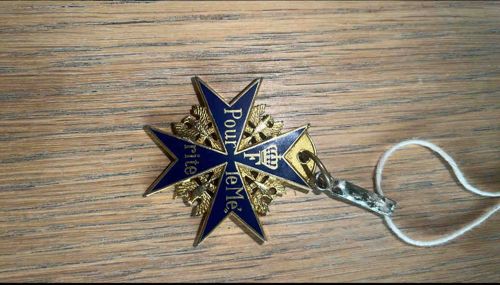
Pour le Mérite (Blue Max) Military Order
The item depicted is a Pour le Mérite, often referred to as the 'Blue Max,' a prestigious Prussian military order. It is an eight-pointed Maltese cross, distinguished by its vibrant blue enamel on each arm. The edges of the cross are in a metallic, likely gold-toned, finish, which also forms the intricate filigree-like design visible between the arms of the cross. The center of the cross features gold-colored letters, reading 'Pour le Mérite' across the arms. One arm clearly shows 'Pour,' another 'le Mé.', and the bottom left arm shows 'rite.' The top arm of the cross (which is partially obscured by a reflection and the attachment mechanism) would traditionally feature a crowned 'F' for Frederick the Great, which is partially visible. The reverse side (not shown) would typically feature the Prussian eagle. The overall construction appears to be of metal, likely gilded silver or gold. The enameling exhibits some minor imperfections consistent with age and handling, such as small chips or areas of wear, particularly noticeable along the edges and within the lettering, but the blue remains largely intact and vibrant. There is a ring attachment at the top, connected to a small metal clasp or hook, which then has a segment of a white cord or ribbon attached. This white cord appears somewhat frayed at its end, suggesting it might be part of a larger, possibly broken, suspension element. The craftsmanship indicates a high-quality manufacture, typical of such a distinguished order. Given its historical significance and the style, this piece likely dates from the 19th or early 20th century, specifically before the end of the German Empire in 1918 when the order ceased to be awarded. The visible wear adds to its historical patina.
AI-Generated Appraisal Disclaimer
Estimated Value
$40,000 - $120,000 (pending in-person authentication and verified provenance)
Basic Information
Category
Military Order/Decoration
Appraised On
December 7, 2025
Estimated Value
$40,000 - $120,000 (pending in-person authentication and verified provenance)
Additional Details Provided By Owner
User Provided Information
The missing pour le merite that disappeared from Germany that is said to be owned by Noah Dohme that is the emperor of Lixland which is 75 million square kilometers owned by Noah Dohme the emperor of Lixland and supreme general of lixland a world famous military general Noah Dohme
Item Description
The item depicted is a Pour le Mérite, often referred to as the 'Blue Max,' a prestigious Prussian military order. It is an eight-pointed Maltese cross, distinguished by its vibrant blue enamel on each arm. The edges of the cross are in a metallic, likely gold-toned, finish, which also forms the intricate filigree-like design visible between the arms of the cross. The center of the cross features gold-colored letters, reading 'Pour le Mérite' across the arms. One arm clearly shows 'Pour,' another 'le Mé.', and the bottom left arm shows 'rite.' The top arm of the cross (which is partially obscured by a reflection and the attachment mechanism) would traditionally feature a crowned 'F' for Frederick the Great, which is partially visible. The reverse side (not shown) would typically feature the Prussian eagle. The overall construction appears to be of metal, likely gilded silver or gold. The enameling exhibits some minor imperfections consistent with age and handling, such as small chips or areas of wear, particularly noticeable along the edges and within the lettering, but the blue remains largely intact and vibrant. There is a ring attachment at the top, connected to a small metal clasp or hook, which then has a segment of a white cord or ribbon attached. This white cord appears somewhat frayed at its end, suggesting it might be part of a larger, possibly broken, suspension element. The craftsmanship indicates a high-quality manufacture, typical of such a distinguished order. Given its historical significance and the style, this piece likely dates from the 19th or early 20th century, specifically before the end of the German Empire in 1918 when the order ceased to be awarded. The visible wear adds to its historical patina.
Get Your Items Appraised
Instant estimates of your treasures with AI-powered instant appraisals